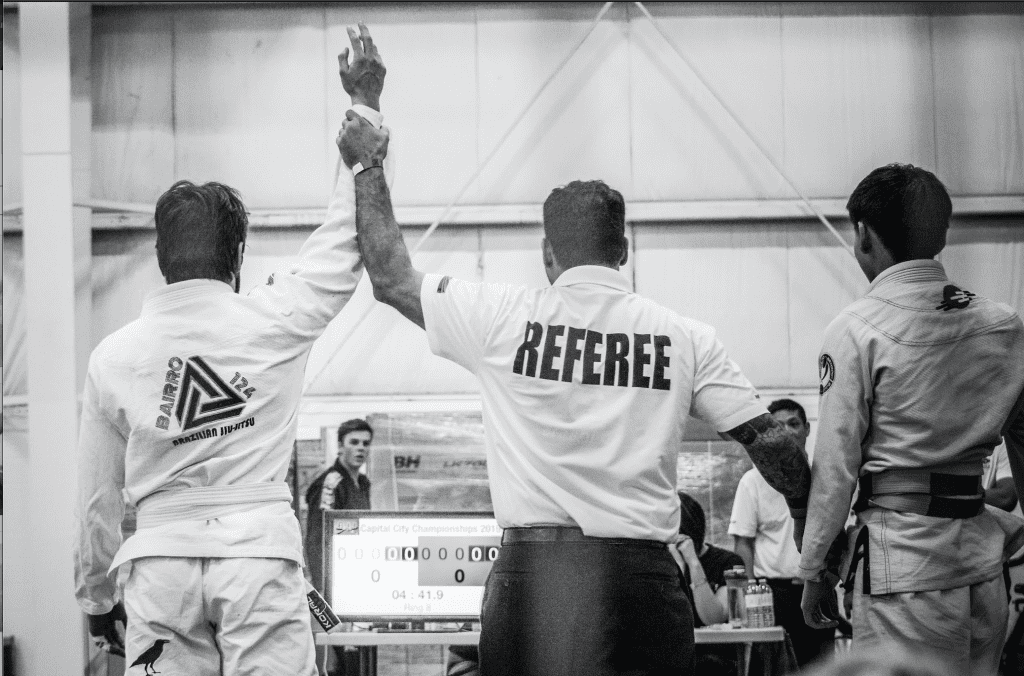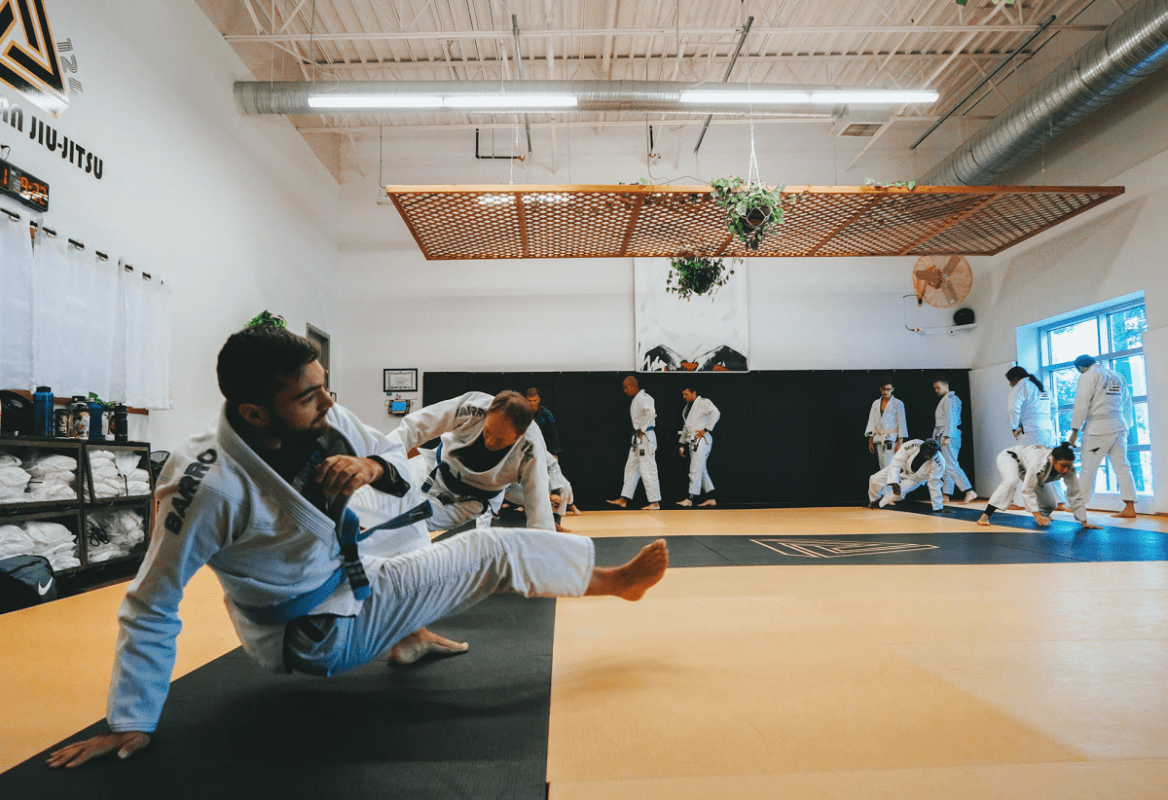For years, Brazilian Jiu-Jitsu was an underground, nearly unknown martial art. In the early 90s, if you did know about BJJ, it was usually through word of mouth. You were lucky enough to know about it, let alone find somewhere that taught it.
While other martial arts were in their heyday, BJJ was quietly gaining momentum in basements and garages. It stood out among the striking-centric martial arts popular at the time due to its effective use of leverage, joint locks, and chokes.
BJJ’s deepest roots trace back to Japan in the early 16th century, where it was practiced and taught as a close combat system designed to disarm and subdue an opponent. After Japan opened to the west in 1853, Jiu-Jitsu began to shift its focus from combat to self-defense with sport elements, and the art began to spread internationally.
In 1908, Brazil brought in the first of many Japanese Jiu-Jitsu instructors to teach military cadets. These instructors moved through the country, performing demonstrations and holding challenges. Gastão Gracie, a business partner of the American Circus, caught wind and hired fighters to perform challenges in his circus. One of Gastao’s children, Carlos Gracie, studied under Japanese instructors during this time.
Carlos began to teach his brothers. For years, the Gracie family refined Brazilian Jiu-Jitsu with challenge matches. Due to the lack of funding in Brazil, many Jiu-Jitsu teachers moved to the United States. California soon became a mecca of Brazilian Jiu-Jitsu, primarily because of its beautiful beach weather that the Brazilians found reminiscent of their home country.
From there, the sport spread internationally and continues to grow at a rapid rate. Here are some of the top reasons why Brazilian Jiu-Jitsu is one of the fastest growing physical activities in the world.
Pressure-tested techniques
The Gracies were confident in their system and relied on challenge matches to promote BJJ’s effectiveness. In the 80s, BJJ schools became notorious for storming Karate schools, looking to prove their art as superior. This “dojo-storming” evolved into the Gracie Challenges: rule-free fights in which any challenger off the street could partake.
But these matches weren’t won by sheer blunt force. Gracie schools infamously only allowed their students to utilize open-hand strikes during the challenges. The goal was never to brutalize but to demonstrate superiority through intelligence and technique. As the art repeatedly proved itself, these challenge matches faded away. BJJ’s notoriety, however, continued to increase.
Unlike other martial arts that enforce a hierarchical power of unquestionable knowledge, Jiu-Jitsu doesn’t cling to the security and sanctity of tradition. It willingly discards anything proven insufficient and tosses aside anything deemed unnecessary.

It’s for everyone
In 1993, the first Ultimate Fighting Championship took place. The event featured a mixture of martial artists and few rules. While the seats were only half full, those in attendance witnessed a man in a white martial arts uniform destroy every opponent set in his path — Even those considerably bigger than himself. This man was BJJ practitioner Royce Gracie. Royce would go on to win UFC 2, 3, 4, and 5, revealing BJJ and its effectiveness to the world.
As a result, BJJ exploded in popularity in the 90s and emerged among martial arts as a great equalizer: a way to beat strength with intelligence. Even within itself, Jiu-Jitsu doesn’t reward muscle — it requires you to earn everything. Competitors in absolute divisions have shown repeatedly that size is only part of the equation.
It is constantly evolving
The early wild days of proving efficiency in Gracie Challenges have faded away, and world-scale competitions have taken their place. As a competition sport, BJJ combines video game-like strategy with dynamic grappling. Here, athletes must focus on the finer details of proficiency.
The exploding popularity of BJJ’s competition and semi-pro scenes have elevated the sport to a new level. Tournaments allow schools to divert their focus away from beating their fellow teammates in favour of growing together to win tournaments.
Advanced athletes are continuously exploring the sport through different lenses.
In our modern age, knowledge is no longer exclusive. Seminars and online instructionals act as a means of spreading knowledge from top-level athletes. The distribution of knowledge presents an exciting opportunity for eager athletes in this up-and-coming sport.
The Journey
The Brazilian Jiu-Jitsu journey is notoriously grinding, often requiring ten years of dedication to reach the level of black belt: a status that can be achieved in under five years in other martial arts. It repeatedly forces you to accept your losses and learn from your mistakes if you wish to progress.
The time it takes to earn a black belt is often compared to completing a doctorate. The journey is perfect for people looking to challenge themselves with its long term, measurable goals.
It demands your best
Brazilian Jiu-Jitsu requires you to show up as your best self or suffer the consequences. BJJ is demanding because it’s trained with full-contact sparring. When you realize your ability to succeed (or sometimes just survive) depends only on you, it may make you rethink some of your choices off the mats.
While the self-defense and fitness aspects initially attract people to bjj for kids near me, many people end up staying because they fall in love with the lifestyle, including the tight-knit communities that develop on the mats. Daily sparing creates deep bonds among people that otherwise might not meet. A communal respect grows as you repeatedly show up for each other. We cannot train BJJ alone. We must have teammates. If we don’t show up as our best selves every day, we are doing a disservice to ourselves and our team.
There is no hidden secret to BJJ. It just requires time. Some might be intimidated by the journey, wondering if they’ll be too old to partake. However, BJJ challenges everyone to take the first step, reminding you that the best time to start is today. As early American BJJ black belt Chris Haueter once said, “You’re going to be somewhere in ten years. You might as well be a black belt.”
So, where will you be in ten years?








